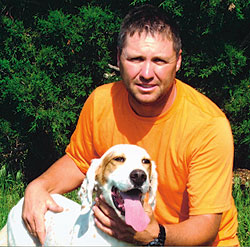By James B. Spencer
 Jim Gourley |
"In dog training, respect must run both ways," Jim said. "Mutual respect builds a bond between you and your dog. By giving your dog the proper mixture of positive and negative training, you show respect for his talents and he learns to respect your authority."
Jim stressed that you can overdo either one. If you overdo the negative, your dog will lose confidence in both himself and you; he won't work enthusiastically; and he may shut down entirely.
If you overdo the positive, you risk creating a monster that knows no behavioral boundaries because you have failed to administer effective corrections. Both extremes produce dogs that are of little value to the hunter.
He said that you can easily spot a dog that has received too much negative training. He lacks self-confidence, works very mechanically, and is too dependent on his owner. You can also easily spot a dog that has had too much positive training. He's too independent, defiant, and self-willed. In extreme cases, he may be aggressive toward people, including his owner.
Jim pointed out that each dog's individual temperament plays a major role in determining the proper mixture of positive and negative training it takes to turn him into the best bird dog he can be.
"For example," he said, "a soft dog will fold up and quit under moderate negative training that wouldn't faze a tough customer. Of course, every dog needs some level of positive reinforcement. It's the trainer's job to determine how much each dog needs."
Jim gave these examples of positive training. In Whoa-training, he first stops the dog with the checkcord, then gives the Whoa command, after which he pets him gently on the sides while applying checkcord pressure.
In developing a dog's ground pattern, he checkcords the dog back and forth across the field; each time the animal comes to the end of the checkcord, he gives a verbal/whistle/hand-signal cue to turn; if the dog doesn't turn, Jim stops and let him figure out that only side-to-side motion is allowed. In steadying a bird dog, he uses launchers, so that whenever the dog decides to take a bird out, Jim can quickly launch it and let the dog learn on his own not to try that.
"Launchers also allow you to create wild flushes," Jim said, "that help you steady your dog."
| Training Retrievers | 

Don't miss tips for your retriever, here, or your spaniel, here
|
|
He gave these examples of negative training. In Whoa-training, Jim stops the dog, and then gives the Whoa command while applying pressure with a slip-lead. In developing a bird dog's ground pattern, he adds a pinch-collar to the above positive technique. In steadying, whenever the dog moves forward after pointing, Jim re-stacks him back where he first pointed.
Jim said that proper sequencing of positives and negatives is as important as the proper mixture. In starting each phase of training, you should use positives until your dog understands what you expect. Then you should add negatives to convince him that you are quite serious about his responses. Thereafter, mix positives and negatives according to the needs of your particular dog.
"Be especially careful with youngsters," he said. "They need lots of positive reinforcement to help instill correct behavior at the start. As they develop, you can add appropriate and humane corrections as needed."
Jim stressed the word "humane." He said you should correct your dog for his benefit, not your own. You should never administer punishment when you are angry, nor should you administer any more than is absolutely necessary.
This tip is from Jim Gourley of Setter Dogs Kennels, 2976 East Milo Drive, Beverly, KS 67423; (785) 249-4316; website www.setterdogs.com; e-mail jim@setterdogs.com. Jim has been training professionally for five years. He trains all sporting breeds, but specializes in pointing breeds. About 90 percent of the dogs he trains are personal hunting dogs; about five percent are field trial dogs; the rest are hunting preserve guides' dogs. He competes in pointing dog field trials and breeds English setters.






